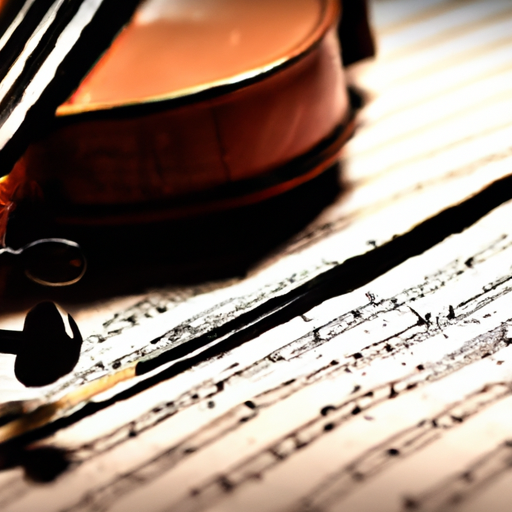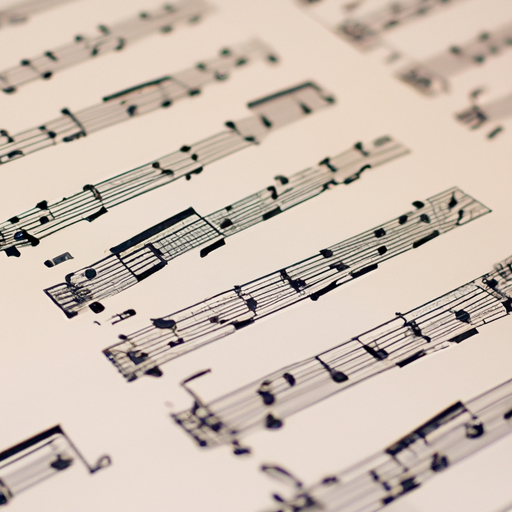
Sheet music reading is the ability to interpret and understand the musical language written on paper. It is an essential skill for any violinist, especially beginners, as it allows them to play a wide range of music and communicate musically with other musicians. Learning how to read sheet music opens up a world of possibilities for violinists, enabling them to explore and perform a vast repertoire.

Before diving into sheet music reading, it is important to familiarize oneself with the basic elements. These include the staff, clef, notes, rests, and time signature.

The staff consists of five horizontal lines and four spaces, upon which music is written. The clef, typically the treble clef for violin, indicates the pitch and range of the instrument. Notes represent the pitch and duration of a sound, while rests denote periods of silence. The time signature, usually found at the beginning of a piece, tells the musician how many beats are in each measure and which note receives the beat.
One of the first steps in sheet music reading for violin beginners is understanding finger placement and the notes on the instrument. In first position, each finger corresponds to a specific note on a specific string.
By memorizing the names of the notes in first position, beginners can quickly locate and play the correct pitches. Utilizing mnemonics, such as "Every Good Boy Deserves Fudge" for the lines on the treble clef or "Good Boys Do Fine Always" for the spaces, can aid in memorization.
Additionally, regular practice and repetition are crucial for solidifying note recognition on the violin. Scales, exercises, and simple tunes provide opportunities to reinforce these skills.
Rhythm is another fundamental aspect of sheet music reading. Different types of notes, such as whole notes, half notes, quarter notes, and eighth notes, represent varying durations. Learning how to count and play these notes accurately is essential.
The time signature plays a significant role in rhythm interpretation. For example, a 4/4 time signature signifies four beats per measure, with a quarter note receiving one beat. Understanding how the time signature affects the rhythm helps musicians maintain a steady tempo.
To practice rhythm, beginners can start with simple exercises, clapping or tapping along to a metronome. Gradually, they can progress to playing rhythms on the violin, combining note values and time signatures.
Sheet music includes bowing techniques that dictate how the violinist should articulate and produce sound. Proper bow hold and arm position are essential for achieving a desirable tone.
The bow hold involves placing the thumb on the frog and the other fingers lightly on the bow. The arm position should be relaxed, allowing for fluid and controlled bowing movements.
Practicing bowing techniques can be done through scales, etudes, and exercises that focus on bow distribution, bow speed, and bow changes. These exercises help violin beginners develop coordination and control.
Reading a simple melody on sheet music involves a step-by-step process. The first step is to identify the notes on the staff and their corresponding pitch on the violin. Then, beginners can analyze the rhythm and determine the duration of each note.
Once the notes and rhythm are understood, beginners can piece together the melody, taking into account the bowing techniques indicated in the sheet music. Regular practice of simple melodies helps violin beginners improve their sheet music reading skills and musical expression.
Dynamics and articulations in sheet music provide instructions on how to play a piece expressively. Dynamic markings, such as piano (p), mezzo forte (mf), and forte (f), indicate the volume level.
Articulation markings, such as staccato or legato, guide the violinist in playing with different bowing techniques and articulations. These markings affect the overall phrasing and interpretation of the music.
Applying dynamics and articulations to a piece of music involves conscious control of bow speed, pressure, and contact point. Experimenting with different bow strokes and listening to recordings of professional violinists can help beginners understand and incorporate dynamics and articulations effectively.
While the 4/4 time signature is the most common, sheet music can also be written in various other time signatures, such as 3/4, 6/8, and more. Understanding different time signatures is crucial for accurately interpreting and playing sheet music.
Counting and playing in different time signatures require focusing on the relationship between beats and subdivisions. Practicing exercises and pieces in different time signatures helps develop rhythmical flexibility and expands a violinist's repertoire.
As beginners learn to read sheet music, they may encounter common mistakes. One such mistake is neglecting to count or follow the rhythm accurately, resulting in a lack of rhythmic precision.
Another common mistake is ignoring dynamic and articulation markings, leading to a flat and expressionless performance. It is essential to pay attention to the details and instructions provided by the composer.
To avoid these mistakes, beginners should take their time, practice slowly, and focus on one aspect of sheet music reading at a time. Seeking guidance from a knowledgeable teacher or utilizing online resources can also help address specific challenges.
Sheet music reading is an invaluable skill for violin beginners. Understanding the basic elements, notes, rhythm, bowing techniques, and other aspects allows violinists to explore a vast repertoire and communicate musically with other musicians.
By practicing regularly, paying attention to details, and seeking guidance when needed, beginners can improve their sheet music reading skills and enhance their overall musicality on the violin. With dedication and perseverance, the journey of learning sheet music reading becomes an exciting and rewarding experience.
Beginners Sheet Music Reading for Violin